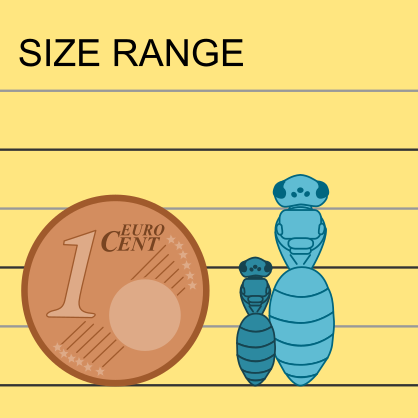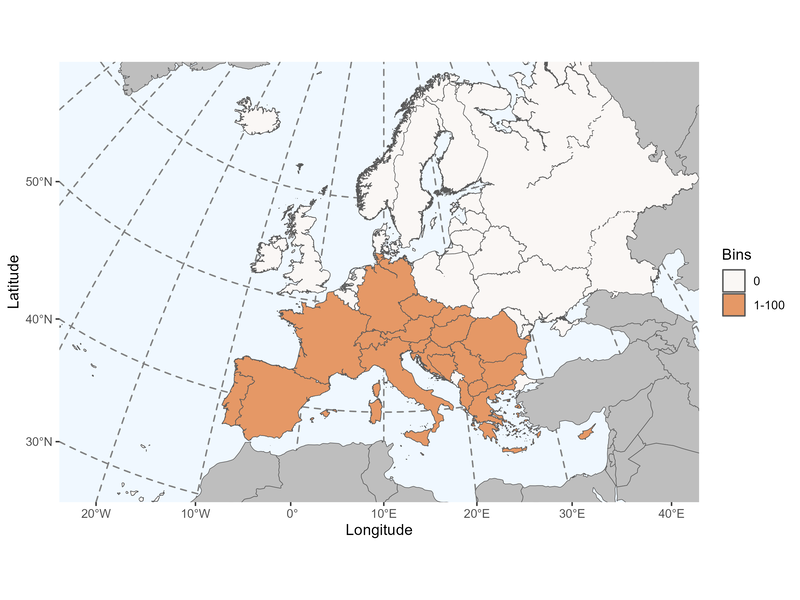Author: Isensee, 1927
|
Type species: Anthidium siculum Spinola, 1838, by original designation.
Subgenera: Asianthidium Popov, 1950; Rhodanthidium s.str. Isensee, 1927. Synonyms: Axillanthidium Pasteels, 1969; Bellanthidium Pasteels, 1969; Meganthidium (Oxyanthidium) Mavromoustakis, 1963. |
Clade: Anthophila
Family: Megachilidae SubF: Megachilinae Tribe: Anthidiini |
|
Distinctive traits
|
Pictures of distinctive traits.
|
Morphologically close genera and how to distinguish them
Trachusa species have a rounded dorso-apical plate of the posterior tibia.
Afranthidium, Anthidium, Icteranthidium & Pseudoanthidium species don't have an arolium between their claws.
Anthidiellum species have a subrectangular, posteriorly extended scutellum and are much smaller.
Eoanthidium species have a carinate antennal fossa.
Stelis species may have pointed axillae, males have two widely separated apical teeth on their anterior and median tibiae and females have no ventral scopa.
Melitturga species have a truncated marginal cell, a second recurrent vein anteriorly connecting at the second submarginal cell, males with enlarged eyes and females without a ventral brush.
- Rhodanthidium - Trachusa
Trachusa species have a rounded dorso-apical plate of the posterior tibia.
- Rhodanthidium - Afranthidium, Anthidium, Icteranthidium & Pseudoanthidium
Afranthidium, Anthidium, Icteranthidium & Pseudoanthidium species don't have an arolium between their claws.
- Rhodanthidium - Anthidiellum
Anthidiellum species have a subrectangular, posteriorly extended scutellum and are much smaller.
- Rhodanthidium - Eoanthidium
Eoanthidium species have a carinate antennal fossa.
- Rhodanthidium - Stelis
Stelis species may have pointed axillae, males have two widely separated apical teeth on their anterior and median tibiae and females have no ventral scopa.
- Rhodanthidium - Melitturga
Melitturga species have a truncated marginal cell, a second recurrent vein anteriorly connecting at the second submarginal cell, males with enlarged eyes and females without a ventral brush.
General comments on Rhodanthidium species identification
Among other criteria, species can be diagnosed on the basis of the teeth and spines on sternites.
Among other criteria, species can be diagnosed on the basis of the teeth and spines on sternites.
Sorry, but the species identification tool is not yet available for Rhodanthidium.
Please check the reference(s) below for traditional keys.
Please check the reference(s) below for traditional keys.
List of the 7 Rhodanthidium species found in Europe (Ghisbain et al. 2023):
Rhodanthidium (Asianthidium) caturigense (Giraud, 1863)
Rhodanthidium (Rhodanthidium) acuminatum (Mocsáry, 1884)
Rhodanthidium (Rhodanthidium) infuscatum (Erichson, 1835)
Rhodanthidium (Rhodanthidium) rufocinctum (Alfken, 1930)
Rhodanthidium (Rhodanthidium) septemdentatum (Latreille, 1809)
Rhodanthidium (Rhodanthidium) siculum (Spinola, 1838)
Rhodanthidium (Rhodanthidium) sticticum (Fabricius, 1787)
Rhodanthidium (Asianthidium) caturigense (Giraud, 1863)
Rhodanthidium (Rhodanthidium) acuminatum (Mocsáry, 1884)
Rhodanthidium (Rhodanthidium) infuscatum (Erichson, 1835)
Rhodanthidium (Rhodanthidium) rufocinctum (Alfken, 1930)
Rhodanthidium (Rhodanthidium) septemdentatum (Latreille, 1809)
Rhodanthidium (Rhodanthidium) siculum (Spinola, 1838)
Rhodanthidium (Rhodanthidium) sticticum (Fabricius, 1787)
References with identification keys for some of the species:
- Kasparek, M. (2019). Bees in the genus Rhodanthidium, a review and identification guide. Entomofauna Supplement 24: 1-123.
- Warncke, K. 1980. Die Bienengattung Anthidium Fabricius, 1804 in der Westpaläarktis und im turkestanischen Becken. Entomofauna 1(10): 119-210.
Page contributors:
You noticed a mistake? You have a suggestion to improve this page?
Don't keep it to yourself, please contact us and become a contributor to IDmyBee!
- Adrien Perrard (Dec. 2023)
- Adrien Perrard (Dec. 2019)
You noticed a mistake? You have a suggestion to improve this page?
Don't keep it to yourself, please contact us and become a contributor to IDmyBee!
References used to write this page:
- Ghisbain, G., Rosa, P., Bogusch, P., Flaminio, S., Le Divelec, R., Dorchin, A., Kasparek, M., Kuhlmann, M., Litman, J., Mignot, M., Müller, A., Praz, C., Radchenko, V.G., Rasmont, P., Risch, S., Roberts, S.P.M., Smit, J., Wood, T.J., Michez, D. & Reverte, S. (2023). The new annotated checklist of the wild bees of Europe (Hymenoptera: Anthophila). Zootaxa, 5327(1), 1-147.
- Michener, C.D. 2007. The Bees of the World, 2nd Edition. The John Hopkins University Press, Baltimore.
- Michez D., Rasmont P., Terzo, M., Vereecken, N. 2019. Abeilles d'Europes. Hymenoptères d'Europes, Volume 1. N.A.P. Editions.
- Nieto, A., Roberts, S. P., Kemp, J., Rasmont, P., Kuhlmann, M., García Criado, M., ... & Michez, D. 2014. European red list of bees. Luxembourg: Publication Office of the European Union, 98.
- Rasmont, P., Devalez, Jelle, Pauly, A., Michez, D. & Radchenko, V.G. 2017. Addition to the checklist of IUCN European wild bees (Hymenoptera: Apoidea). Annales de la Société entomologique de France 53: 17-32.



